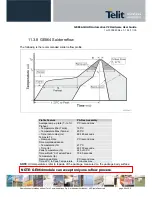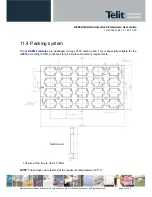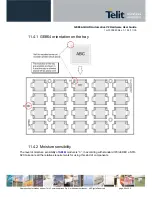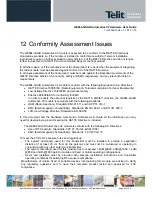
GE864-QUAD Automotive V2 Hardware User Guide
1vv0300840 Rev.0.1 24/11/09
Reproduction forbidden without Telit Communications S.p.A. written authorization - All Rights Reserved
page 48 of 65
10.5 Using the RFTXMON Output GPIO5
The GPIO5 pin, when configured as RFTXMON Output, is controlled by the GE864-QUAD Automotive
V2 module and will rise when the transmitter is active and fall after the transmitter activity is
completed.
The TXMON pin behaviour can be configured using the AT command.
# TXMONMODE
Refer to AT Commands Reference Guide
80000ST10025a
for the full description of this command.
For example, if a call is started, the line will be HIGH during all the conversation and it will be again
LOW after hanged up.
The line rises up 300ms before first TX burst and will became again LOW from 500ms to 1sec after
last TX burst.
10.6 Using the Alarm Output GPIO6
The GPIO6 pad, when configured as Alarm Output, is controlled by the GE864-QUAD Automotive V2
module and will rise when the alarm starts and fall after the issue of a dedicated AT command.
This output can be used to power up the GE864-QUAD Automotive V2 controlling microcontroller or
application at the alarm time, giving you the possibility to program a timely system wake-up to achieve
some periodic actions and completely turn off either the application and the GE864-QUAD Automotive
V2 during sleep periods, dramatically reducing the sleep consumption to few
μ
A.
In battery-powered devices this feature will greatly improve the autonomy of the device.
NOTE: During RESET the line is set to HIGH logic level.
10.7 Using the Buzzer Output GPIO7
The GPIO7 pad, when configured as Buzzer Output, is controlled by the GE864-QUAD Automotive V2
module and will drive with appropriate square waves a Buzzer driver.
This permits to your application to easily implement Buzzer feature with ringing tones or melody
played at the call incoming, tone playing on SMS incoming or simply playing a tone or melody when
needed by your application.
















































